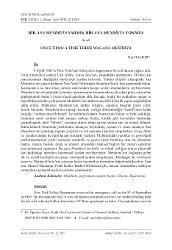| dc.contributor.author | Balkır Kuru, Nur | |
| dc.date.accessioned | 2020-08-24T09:22:13Z | en_US |
| dc.date.available | 2020-08-24T09:22:13Z | en_US |
| dc.date.issued | 2018 | en_US |
| dc.identifier.issn | 1300-5707 | en_US |
| dc.identifier.issn | 2636-8064 | en_US |
| dc.identifier.uri | https://hdl.handle.net/20.500.12469/3236 | |
| dc.identifier.uri | https://search.trdizin.gov.tr/yayin/detay/329294 | |
| dc.description.abstract | 8 Eylül 1985’te New York’taki Soho polis departmanı bir acil durum çağrısı aldı.
Ünlü minimalist sanatçı Carl Andre, karısı Ana’nın, yaşadıkları apartmanın 34’üncü kat
penceresinden düştüğünü söyleyerek yardım istiyordu. Yardım ekipleri ulaştığında Ana
Mendieta’nın cansız bedenini New York Performans Sanatları Okulu’nun çaprazında buldu.
Komşuları kısa süre önce onların dairesinden kavga sesleri duyduklarını söylüyorlardı.
Mendieta’nın vücudundaki izlerden ve pencerenin konumundan yola çıkan polis, cinayetten
şüphelenerek Andre’yi zanlı olarak gözaltına aldı. Davada, Andre’nin avukatları, sanatı ve
hayat hikayesinden yola çıkarak Mendieta’nın intihara meyilli bir kişilik yapısı sergilediğini
iddia ettiler. Mahkeme, Mendieta’nın intihar ettiğine, sanatına bakarak karar verdi.
İronik biçimde, Mendieta’nın toprağı kazarak varlığa dönüştürdüğü “kendi”nden kalan
boşluğu “intihara meyilli beden” ile doldurup kapattı. Sanatçının ölümü ve fiziki yokluğu,
sanatının temel soruları olan zaman, mekan, beden, kimlik gibi kavramlar etrafından
yorumlanarak ünlü “Silueta” serisinin altına, tabiri caizse serinin son işi olarak eklendi.
Küba kökenli Amerikalı performans sanatçısı, heykeltraş, ressam ve video sanatçısı Ana
Mendieta’nın yarattığı imgeler yeryüzü ve ruh arasında ilişkileri sorgularken, sevgi, ölüm
ve yeniden doğuş ile ilgili hayati sorularla yüzleşir. İlk başlardaki yenilikçi ve provokatif
performanslarının yerini sonraları sembolik ve geçici işlere bırakmış olsa da, Mendieta
beden, zaman, boşluk, doğa ve onların arasındaki ilişkisel bağları her zaman sanatının
ana malzemesi yapmıştır. Bu yazı, Mendieta’nın fiziki ve ruhsal varlığını ortaya çıkarmak
için kullandığı metotları kavramsal açıdan inceleyecektir. Mendieta’nın doğuştan gelen
ırk ve cinsel kimliğini ayrıştırıp varoluşsal açıdan sorgulaması, Heidegger’in varoluşsal
uzam ve Merleau Ponty’nin yaşayan beden kavramları üzerinden değerlendirilecektir. Yanı
sıra, Marcel Duchamp, Frida Kahlo, Rachel Whiteread gibi, benzer sorunsalları irdeleyen
sanatçıların çalışmalarıyla kıyaslama yapılacaktır. | en_US |
| dc.description.abstract | New York Police Department received an emergency call on the 8th of September
in 1985. On the opposite end, it was the famous minimalist artist Carl Andre pleading help
for his wife who had fallen from their 34th floor apartment in Soho. The ambulance arrived at the location only to find Ana Mendieta’s lifeless body. There were no eyewitnesses.
The neighbours’ gave statements of loud arguments coming from their apartment a few
days prior to the event. Investigators took Carl Andre into the custody suspecting seconddegree murder due to the injuries on Mendieta’s body and the position of the window. After
a three-year trial, Andre’s lawyers presented a defence claiming that Mendieta is likely
to have had a suicidal personality due to her art and her life story. The court eventually
decided that Mendieta had committed suicide after examining her art, and acquitted Carl
Andre of the murder case. Mendieta had turned the ‘void’ into an entity through digging the
earth, and the court closed the void filling it with a ‘suicidal body’. The death of the artist
and her subsequent non-existence, gives a connotative link to her art; centered on crucial
questions about time, space, body, and identity, seemed to be the final addition to her
famous ‘Silueta’ series. Cuban American performance artist, sculptor, painter, film maker
Ana Mendieta analyzes the relation between the earth and spirit, and confronts us with
painful questions like love, death and rebirth. Since the majority of her work consists of
bodily performances, Mendieta questions the concept of ephemerality over the body, spirit
and existence. Although her initial innovative and provocative performances were later
replaced by her symbolic and transient work, the matters of body, time, space, and nature
and their connectedness continued to become the main ingredients of Mendieta’s art. This
paper will conceptually analyze Mendieta’s methods of expression in her constant search of
her physical and spiritual presence. Mendieta’s questioning and dissecting of such presence
and her raced and gendered self requires an existential exploration. This paper will examine
Mendieta’s approach through concepts of phenomenologists Heidegger’s existential space
and Merleau Ponty’s ‘lived body’, which describes the roles of sensation in perception.
Furthermore, Mendieta’s works will be compared to the works of Marcel Duchamp, Frida
Kahlo and Rachel Whiteread on the basis of shared concepts. | en_US |
| dc.language.iso | tur | en_US |
| dc.publisher | Ege Üniversitesi, Edebiyat Fakültesi | en_US |
| dc.rights | info:eu-repo/semantics/openAccess | en_US |
| dc.subject | Mendieta | en_US |
| dc.subject | Performans sanatı | en_US |
| dc.subject | Beden | en_US |
| dc.subject | Silueta | en_US |
| dc.subject | Rupestrian | en_US |
| dc.subject | Mendieta | en_US |
| dc.subject | Performance art | en_US |
| dc.subject | Earth-body art | en_US |
| dc.subject | Silueta | en_US |
| dc.subject | Rupestrian | en_US |
| dc.title | BİR ANA MENDİETA VARMIŞ, BİR ANA MENDİETA YOKMUŞ | en_US |
| dc.type | article | en_US |
| dc.identifier.startpage | 251 | en_US |
| dc.identifier.endpage | 263 | en_US |
| dc.relation.journal | Sanat Tarihi Dergisi | en_US |
| dc.identifier.issue | 1 | en_US |
| dc.identifier.volume | 27 | en_US |
| dc.department | Fakülteler, İletişim Fakültesi, Görsel İletişim Tasarımı Bölümü | en_US |
| dc.institutionauthor | Balkır Kuru, Nur | en_US |
| dc.relation.publicationcategory | Makale - Ulusal Hakemli Dergi - Kurum Öğretim Elemanı | en_US |
| dc.identifier.trdizinid | 329294 | en_US |
















